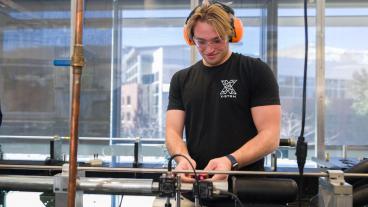Interchangeable electric vehicle powertrain wins top honors at Spring 2024 Capstone Design Showcase
Electric vehicle powertrain will be used by mechanical engineering students at Mines for lab class

Cruz Strom and Oliver Noyes, members of the team that won first place overall at the Spring Capstone Design Showcase, discuss their project, an interchangeable electric vehicle powertrain.
A team that developed an electric vehicle powertrain that can be quickly interchanged with an internal combustion engine for an automotive lab class at Mines won the top prize at the Spring 2024 Capstone Design Showcase.
A powertrain is the system in a motor vehicle that generates and delivers power. In an internal combustion engine, that power is generated by the burning of fuel, often gasoline. In an electric vehicle, the motor is powered by energy stored in a battery.
For their project, the winning team was challenged to create a powertrain that relies on electric power but works in a chassis already built for a combustion engine. To do that, the team had to match the electric powertrain to the existing combustion engine’s mass, weight and top speed.
“Our team was full of passionate people who were excited about the project and willing to work hard to get it done and do it well, so seeing that work recognized was extremely gratifying,” the team said in a statement. “We all gained technical knowledge about EV powertrains but the experience of getting to start and finish a big project on a large team, be responsible for our own timeline and goals along the way, and manage setbacks, was incredibly valuable.”
The new electric vehicle powertrain will be used by mechanical engineering students in an automotive lab class. The students will have the opportunity to better understand how the two different powertrains perform, both individually and interchangeably in a vehicle.
Members of the winning team include Luke Carroll, Kaihl Garcia, Asher Hogan, Ben Jones, Tyler Jorgensen, Sten Joyner, Colten Kristie, Katie Lake, Matthew Maness, Oliver Noyes, Sam Pearse, Nic Roma and Cruz Strom. The team’s faculty advisor was Michael Sheppard, teaching assistant professor in engineering, design and society.
Capstone Design is a signature student experience at Mines that tasks student teams with producing creative, client-driven solutions to real-world problems. Paired with sponsors from the community, students combine their knowledge in civil, electrical, mechanical, environmental and design engineering to create projects that address realistic, multidisciplinary challenges. The year-long experience ends with Capstone Design Showcase, where teams present their ideas and prototypes to sponsors, judges and members of the Mines community.
Second place at this semester’s showcase went to NASA Robotic Mining – Lunabotics. The team represented Mines at this year’s NASA Robotic Mining Competition, where they built a prototype lunar rover that performed in a simulated lunar environment. Using some components from last year’s team, they created a largely new design with a fully autonomous system that uses a camera to locate obstacles in 3D.
NASA Robotic Mining – Lunabotics team members included Austin Beebe, Brad Dechant, Tristan DeVries, Jack Egger, Hayden Fleming, Luke Hawkins, Jacob Hemard, Shaun Hoerner, Max Kugel, Colin McCormick, Ben McDill and Cole Scott.
Third place went to Milwaukee Tool Auto Industrial Vac Robot. The team redesigned and advanced an autonomous vacuum system created by a previous Capstone Design team. The device collects sawdust in a dynamic woodshop while automatically planning a navigation path and avoiding obstacles.
Milwaukee Tool Auto Industrial Vac Robot team members included Gabe Berland, Cole Chapman, Isaac Chase, Kurtis Daniels, Taylor Henry, Eric Sobczak, Forest Valentine and Max Weinberger.
The ICE Swap to Electric in Sunbeam Classic Car team was recognized with the Engineering Integrity Award. Members of that team were Blake Bent, Morgan Bergdahl, Stephan Legarburo, Reece Noel, Elena Ramirez, Hayden Ray, Scott Reeder, Jamie Regan and Christopher Sarff.
Capstone projects were also recognized for their innovation, societal impact and proof of concept:
- Best Innovation: NASA Human Lander Challenge
- Best Societal Impact: (tie) Temperature Control Dog Kennel and Decarbonizing Mines Electricity
- Best Environmental Impact: JeffCo Campus Solar Resources Evaluation
- Best Human Systems: Skeletal Range of Motion Tracking and Measuring
- Best Proof-of-Concept: (tie) CIA Threat Awareness System and The Ball Buddy
The Spring 2024 Broader Impact Essay winners were:
- First place: Katie Lake for “Electric Vehicles, Materials, and their Broader Costs”
- Second place: Hayden Payne for “Embracing the Reality of Automation in the Fourth Industrial Revolution”
- Third place (tie): Yosef Adler for “Charting the Celestial Frontier: The Profound Impact of Aerospace-Engineered Systems on Society, Environment, and Economy” and Aiden Ferry for “Electric Bikes: A Superior Form of Transportation”




